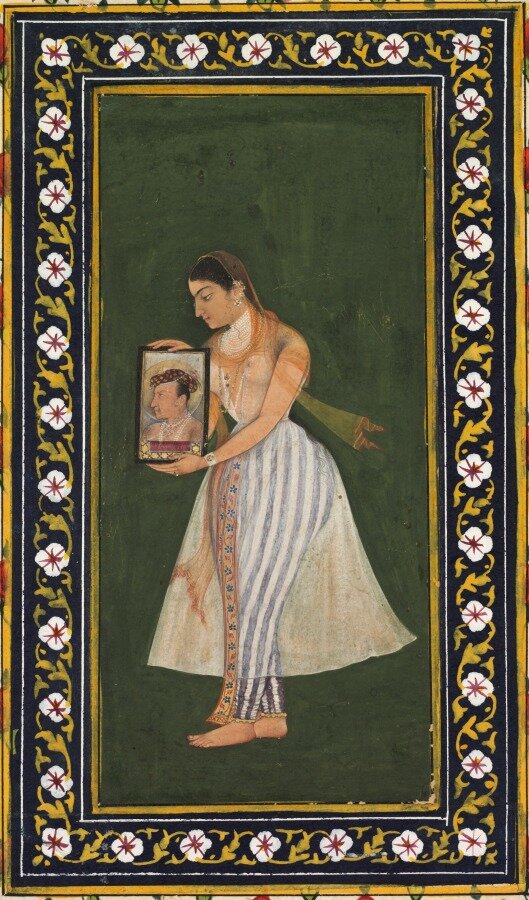The Mughal Saga
An exhibition on Mughal Miniature Paintings
The Mughal Empire is counted as among the most extravagant and powerful empires to have existed in the Indian subcontinent, as also the world. Established in the 16th century and extending its reign till the 19th century, the Empire is recognized for its military strength, grandeur and patronage to art and aesthetics. One such magnificent art form that developed was the Mughal Miniature Paintings, exhibiting the talents of the craftspersons of that time. This exhibition showcases a small collection of some of these paintings, exploring the course of the Empire through it. It also aims to put forward the art styles that flourished in the Empire in different periods.
Baburnama C.1590. The Metropolitan Museum of Art.
“Emperor Babur receiving a visitor”
Babur laid the foundations of the Mughal State in 1526. An avid writer, he wrote his adventures in Chagatai Turkic. It was later translated to Persian by his grandson Akbar and titled “Baburnama.” Made by the artist Madhu, one sees Safavid Persian influences in this painting. There are delicate depictions of birds and the fauna.
Akbarnama C.1596-97 or 1604. Cleveland Museum of Art.
“Babur receives booty and Humayun’s salute after victory over Sultan Ibrahim”
The art of painting was forbidden according to orthodox Muslim opinion. Hence, it was promulgated by royal patronage. Humayun, Babur’s heir, had brought with him Persian painters and laid the foundations of painting among the Mughals.
Shah Jahan album Verso c. 1630 Recto c. 1530-50. The Metropolitan Museum of Art.
“Akbar with Lion and Calf”
Akbar helped the Mughal State reach its zenith and made it an empire. He was the first one who established an atelier for manuscripts and paintings. Extending patronage led to thronging of indigenous painters to the court. This beautiful miniature has been painted by Govardhan and one sees a halo around Akbar. This was a symbol of divine power associated with the Mughals that was portrayed to their subjects.
Akbarnama c. 1604. The Metropolitan Museum of Art.
“Akbar hunting with Cheetahs”
The influence of European prints also entered the realms of the atelier. Artists were drawn to the figural types, the use of shading to indicate volume, and the element of naturalism in European art, as well as the presence of distant landscapes in the background. Attributed to Manohar, we see numerous layers in the painting that provide depth and shadows.
c. 1615-1620. The Metropolitan Museum of Art.
“Portrait of Emperor Jahangir”
With Jahangir’s accession to the throne, the miniatures reached an artistic high. The paintings became grander and more colourful, with intricate patterns made in a beautiful manner. A lover of nature, Jahangir commissioned albums on flora and fauna and studied them with a lot of interest. In this particular portrait, one sees elegant calligraphy on the borders, a typical feature of Mughal miniatures.
c. 1627. Cleveland Museum of Art.
“Nur Jahan Holding a Portrait of Emperor Jahangir”
Nur Jahan, Jahangir’s favourite wife, was a remarkable force and held immense power over the affairs of the court. She defied norms and made lives better for other women as well. It was extremely rare for a woman to be portrayed in an artistic work, but Nur had her life painted.. This miniature has been made by Bishandas and may have been made shortly after Jahangir’s death. One can see an aged Jahangir with a halo, signifying his passing away.
Shah Jahan Album verso c.1630 recto c. 1530-50. The Metropolitan Museum of Art.
“Shah Jahan on Horseback”
When Shah Jahan ascended the throne post Jahangir’s death, miniatures reflected his fondness for architecture. They became more structured and rigid. The focus shifted again towards projecting a mighty image of the ruler and the empire. The artist Payag has put forth a brilliant example of the same here, showcasing Shah Jahan riding a glorious stallion, radiating power and piety.
c. 17th/18th century. The Art Institute of Chicago.
“Lovers in a Zenana Garden at Night”
Shah Jahan’s son Aurangzeb was not fond of art . Thus, in a few years of his reign, the court painters started migrating to the vibrant bazaars of the empire, capturing the natives and the noblemen. Some of the finest miniatures come forth from this period. Also, patronage from regional kingdoms of the subcontinent resulted in influence of Mughal art on their paintings. Portrayed here is lovely scene of a couple enjoying time together in their quarters.








